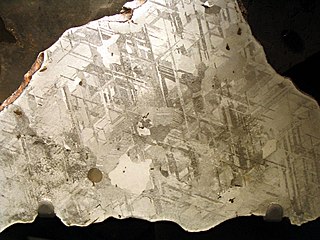
Kamacite is an alloy of iron and nickel, which is found on Earth only in meteorites. The proportion iron:nickel is between 90:10 and 95:5; small quantities of other elements, such as cobalt or carbon may also be present. The mineral has a metallic luster, is gray and has no clear cleavage although its crystal structure is isometric-hexoctahedral. Its density is about 8 g/cm3 and its hardness is 4 on the Mohs scale. It is also sometimes called balkeneisen.
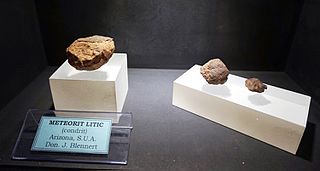
A meteorite classification system attempts to group similar meteorites and allows scientists to communicate with a standardized terminology when discussing them. Meteorites are classified according to a variety of characteristics, especially mineralogical, petrological, chemical, and isotopic properties.

A chondrule is a round grain found in a chondrite. Chondrules form as molten or partially molten droplets in space before being accreted to their parent asteroids. Because chondrites represent one of the oldest solid materials within the Solar System and are believed to be the building blocks of the planetary system, it follows that an understanding of the formation of chondrules is important to understand the initial development of the planetary system.

A chondrite is a stony (non-metallic) meteorite that has not been modified, by either melting or differentiation of the parent body. They are formed when various types of dust and small grains in the early Solar System accreted to form primitive asteroids. Some such bodies that are captured in the planet’s gravity well become the most common type of meteorite by arriving on a trajectory toward the Earth’s surface. Estimates for their contribution to the total meteorite population vary between 85.7% and 86.2%.

Troilite is a rare iron sulfide mineral with the simple formula of FeS. It is the iron rich endmember of the pyrrhotite group. Pyrrhotite has the formula Fe(1-x)S which is iron deficient. As troilite lacks the iron deficiency which gives pyrrhotite its characteristic magnetism, troilite is non-magnetic.

The iron meteorites of the IIE chemical type are octahedrites of various coarseness, most of which contain numerous inclusions of recrystallized stony silicates.

The H type ordinary chondrites are the most common type of meteorite, accounting for approximately 40% of all those catalogued, 46% of the ordinary chondrites, and 44% of the chondrites. The ordinary chondrites are thought to have originated from three parent asteroids, whose fragments make up the H chondrite, L chondrite and LL chondrite groups respectively.

The ordinary chondrites are a class of stony chondritic meteorites. They are by far the most numerous group and comprise about 87% of all finds. Hence, they have been dubbed "ordinary". The ordinary chondrites are thought to have originated from three parent asteroids, with the fragments making up the H chondrite, L chondrite and LL chondrite groups respectively.

The L type ordinary chondrites are the second most common group of meteorites, accounting for approximately 35% of all those catalogued, and 40% of the ordinary chondrites. The ordinary chondrites are thought to have originated from three parent asteroids, with the fragments making up the H chondrite, L chondrite and LL chondrite groups respectively.

The LL chondrites are a group of stony meteorites, the least abundant group of the ordinary chondrites, accounting for about 10–11% of observed ordinary-chondrite falls and 8–9% of all meteorite falls. The ordinary chondrites are thought to have originated from three parent asteroids, with the fragments making up the H chondrite, L chondrite and LL chondrite groups respectively. The composition of the Chelyabinsk meteorite is that of a LL chondrite meteorite. The material makeup of Itokawa, the asteroid visited by the Hayabusa spacecraft which landed on it and brought particles back to Earth also proved to be type LL chondrite.
Keilite is an iron-magnesium sulfide mineral with the chemical formula (Fe,Mg)S) that is found in enstatite chondrites. Keilite is the iron-dominant analog of niningerite. Keilite is named after Klaus Keil.

The Allende meteorite is the largest carbonaceous chondrite ever found on Earth. The fireball was witnessed at 01:05 on February 8, 1969, falling over the Mexican state of Chihuahua. After breaking up in the atmosphere, an extensive search for pieces was conducted and over 2 tonnes (tons) of meteorite were recovered. The availability of large quantities of samples of the scientifically-important chondrite class has enabled numerous investigations by many scientists; it is often described as "the best-studied meteorite in history." The Allende meteorite has abundant, large calcium-aluminium-rich inclusions (CAI), which are among the oldest objects formed in the Solar System.

Pultusk is an H5 ordinary chondrite meteorite which fell on 30 January 1868 in Poland. The event has been known as the stony meteorite shower with the largest number of pieces yet recorded in history. Made up of rocky debris, it consists of pyroxene or olivine chondrules deployed in mass plagioclase, there being also kamacite.
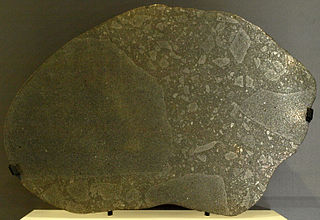
Enstatite chondrites are a rare form of meteorite thought to comprise only about 2% of the chondrites that fall on Earth. Only about 200 E-Type chondrites are currently known.

Domenico Troili (1722–1792) was an Italian abbate and a Jesuit, who held the appointment of custodian of the library of the ruling family of Este in Modena. He is recognized as the first person who documented the fall of a meteorite, in 1766.
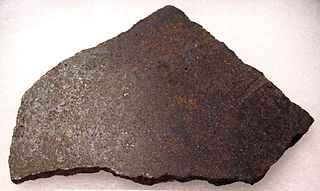
Arroyo Aguiar is an H chondrite meteorite that fell to earth during the summer of 1950 in the province of Santa Fe, Argentina.
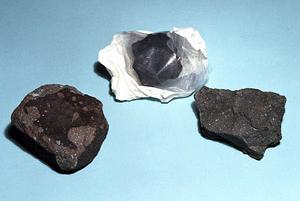
CI chondrites, sometimes C1 chondrites, are a group of rare stony meteorites belonging to the carbonaceous chondrites. Samples have been discovered in France, Canada, India, and Tanzania. Compared to all the meteorites found so far, their chemical composition most closely resembles the elemental distribution in the sun's photosphere.
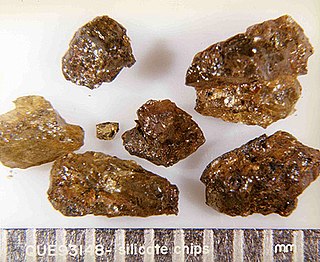
Lodranites are a small group of primitive achondrite meteorites that consists of meteoric iron and silicate minerals. Olivine and pyroxene make up most of the silicate minerals. Like all primitive achondrites lodranites share similarities with chondrites and achondrites.
This is a glossary of terms used in meteoritics, the science of meteorites.
Mason Gully is an ordinary chondrite of subclass H5, and is the second meteorite to be recovered using the Desert Fireball Network (DFN) camera observatory. One stone weighing 24.5g was observed to fall by the Desert Fireball Network observatory in Western Australia on 13 April 2010 at 10h36m10s UTC. It was recovered by the DFN on 3 November 2010 by Dr. R. Merle and the Fireball network recovery team, and was found 150m from its predicted fall location based upon the observed trajectory and calculated mass.















